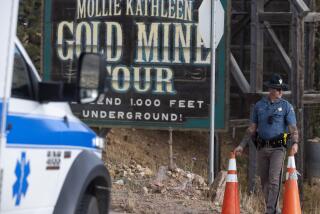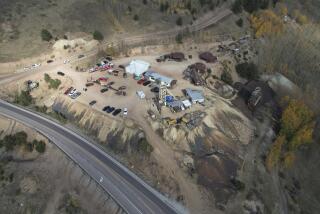Companies, federal agency faulted in Utah mine tragedy
- Share via
SALT LAKE CITY — The collapse of the Crandall Canyon mine one year ago was so extensive that federal officials found no other mining disaster in the last 50 years to compare to it.
Hundreds of coal pillars, overloaded by aggressive mining that carved out too many voids, collapsed within seconds on Aug. 6, 2007, entombing six miners nearly half a mile underground. Satellite radar images show that a 69-acre section of the mine caved in -- the equivalent of about 63 football fields.
The Mine Safety and Health Administration said the mine was “destined to fail” because the mining company made critical miscalculations and didn’t report early warning signs. But the agency itself also was faulted by its parent agency, the Department of Labor, for lax oversight before the collapse and for its handling of a haphazard rescue effort that left three more people dead.
Regulators say the rescue tunneling should never have been attempted because it only made the mine more unstable.
At each step of the way, starting months before the disaster, Crandall Canyon was doomed, according to 1,400 pages of government and congressional reports.
A day of reckoning came two weeks ago, with the Department of Labor scolding the mining agency, asserting that it had rubber-stamped a risky mining plan and launched an ill-conceived rescue effort that left nobody clearly in charge.
Earlier that day, the mining agency blamed a subsidiary of Ohio-based Murray Energy Corp. for unauthorized coal digging and its engineers for a series of blunders related to Crandall Canyon’s supposed stability.
Federal prosecutors are considering criminal charges. The mining agency cited Murray Energy affiliate Genwal Resources Inc. for negligence. Engineering firm Agapito Associates Inc. of Grand Junction, Colo., was cited for “reckless disregard.” The companies were fined $1.8 million, the largest fines ever levied on a U.S. coal-mining operation.
The mining agency found that long-wall mining had weakened both sides of the tunnels that collapsed, even before Genwal Resources took over in 2006.
At first, city-block-size coal barriers -- 450 feet wide and three-quarters of a mile long -- protected both sides of the tunnels from the extensively mined “gobs” beyond the barriers. The mountain reacted to those gobs by transferring more weight onto the barrier pillars. But Genwal’s aggressive mining whittled the barriers to as narrow as 135 feet.
As early as March 2007, pillars started unexpectedly collapsing. The mining agency said Crandall Canyon failed to notify the agency of the early danger signs, but the company and its lawyers dispute that.
Other government reports say the agency was given enough information about a devastating but nonlethal collapse on March 10 but failed to act or even inspect the damage.
More to Read
Sign up for Essential California
The most important California stories and recommendations in your inbox every morning.
You may occasionally receive promotional content from the Los Angeles Times.










